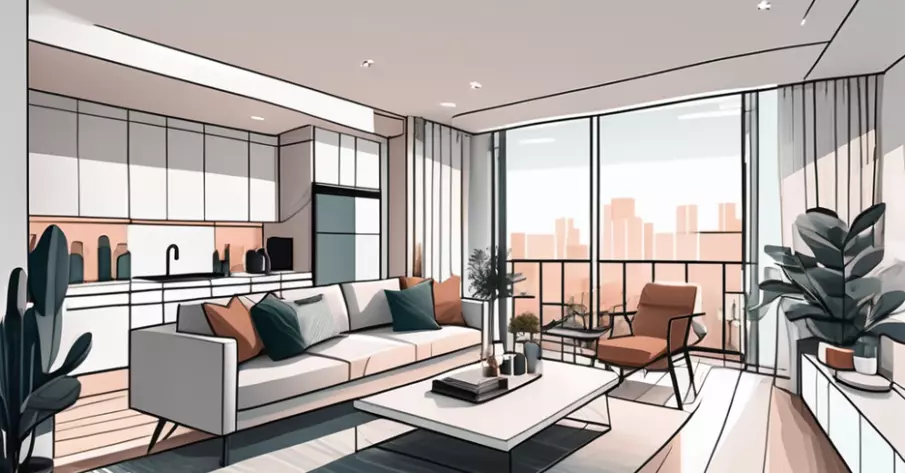The Art of Staging Apartments: A Guide for New Agents

Discover the secrets of successful apartment staging with our comprehensive guide tailored for new real estate agents.
Staging apartments is a crucial aspect of real estate marketing. It's an art that transforms an empty or cluttered space into a captivating, inviting home. This guide is designed to provide new agents with the necessary insights and techniques to master this art and make a lasting impression on potential buyers. If you want to know more about becoming a real estate agent you can follow this 6-step guide on getting a real estate license New York.
Understanding the Importance of Staging
Before diving into the techniques of staging, it's essential to understand its significance in the real estate business. Staging is not merely about decorating a space; it's about creating a vision for potential buyers. It allows them to visualize the apartment as their future home, evoking emotions that can influence their purchasing decision.
Moreover, staging can significantly increase the perceived value of an apartment. A well-staged apartment can command a higher price and sell faster than a non-staged one. It's an investment that can yield substantial returns for both agents and sellers.
Key Elements of Staging
Staging involves several key elements, each contributing to the overall appeal of the apartment. These elements include cleanliness, decluttering, furniture arrangement, lighting, and decor.
Cleanliness
The first step in staging an apartment is ensuring it's spotless. A clean apartment not only looks appealing but also signals to buyers that the property has been well-maintained. Pay attention to every detail, from the floors and windows to the kitchen countertops and bathroom tiles.
Decluttering
Decluttering is another crucial aspect of staging. A cluttered space can appear smaller and less appealing. Remove unnecessary items and create a sense of spaciousness. This also allows buyers to focus on the apartment's features rather than the clutter.
Furniture Arrangement
The way furniture is arranged can significantly impact the perception of space. Strategically arrange furniture to highlight the apartment's strengths and downplay any weaknesses. For instance, placing a large mirror in a small room can create an illusion of space.
Lighting
Lighting plays a vital role in setting the mood and highlighting the apartment's best features. Make the most of natural light and supplement it with artificial lighting where necessary. Warm, soft lighting can create a cozy and inviting atmosphere.
Decor
The decor should complement the apartment's style and appeal to a broad range of buyers. Avoid personal items and choose neutral colors and accessories that add a touch of elegance without overpowering the space.
Staging Techniques
Now that we've covered the key elements of staging, let's delve into some effective techniques that can enhance your staging skills.
Use of Mirrors
Mirrors are a stager's best friend. They can make a room appear larger, brighter, and more inviting. Place mirrors strategically to reflect light and create a sense of depth.
Color Psychology
Colors can evoke emotions and influence perceptions. Use color psychology to your advantage. For instance, blues can create a calming effect, while yellows can evoke happiness and energy.
Accessorizing
Accessories can add personality and charm to a space. However, it's important to strike a balance. Too few can make a space feel bare, while too many can create clutter. Choose accessories that complement the apartment's style and color scheme.
Common Staging Mistakes to Avoid
While staging can enhance an apartment's appeal, certain mistakes can have the opposite effect. Here are some common staging mistakes to avoid.
Over-staging
Over-staging can make a space feel artificial and uninviting. Avoid too many accessories or furniture pieces that crowd the space. The goal is to create a warm, inviting atmosphere that allows buyers to envision themselves living in the apartment.
Ignoring the Target Market
Staging should cater to the tastes and preferences of the target market. Ignoring this can result in a disconnect between the staging and the potential buyers. Research your target market and stage the apartment accordingly.
Neglecting Curb Appeal
The exterior of the apartment building is the first thing buyers see. Neglecting curb appeal can create a negative first impression. Ensure the exterior is clean, well-maintained, and inviting.
Conclusion
Staging is an art that requires creativity, attention to detail, and an understanding of the real estate market. By mastering this art, new agents can enhance their marketing efforts, attract more buyers, and expedite the selling process. Remember, the goal of staging is not just to sell an apartment, but to sell a vision of a desirable lifestyle.
More to Read:
Previous Posts:











